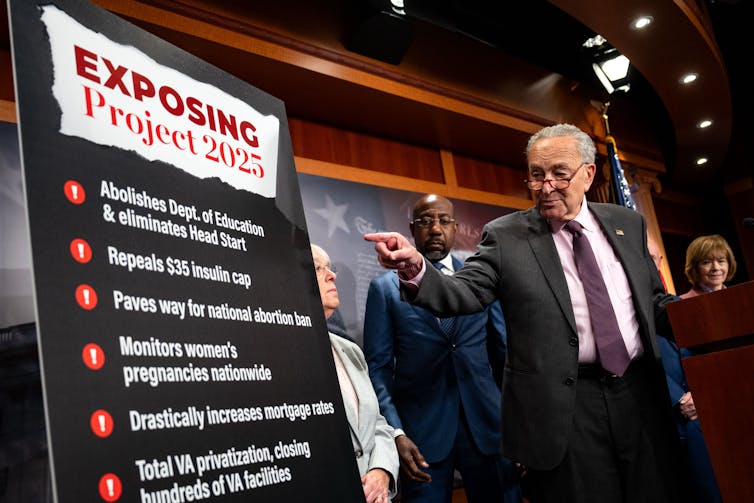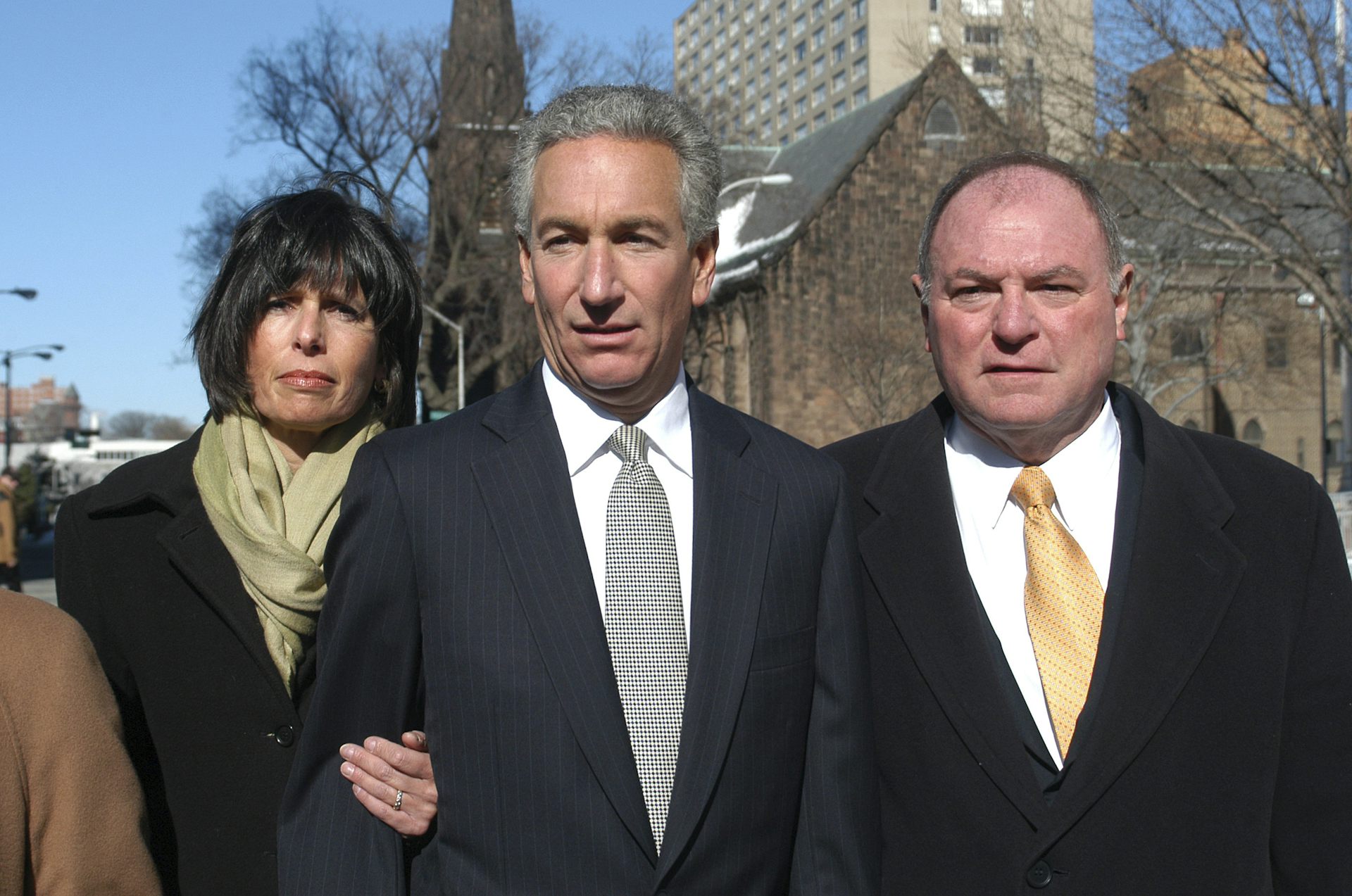Trump’s administration seems chaotic, but he’s drawing directly from Project 2025 playbook
Many of Trump’s executive orders mirror plans laid out in Project 2025, a conservative policy plan developed in part by the Heritage Foundation.

In his first few days back in office, President Donald Trump engaged in a whirlwind of executive actions, from exiting the World Health Organization, to deploying military personnel and National Guard troop to the U.S.-Mexico border.
Many of these actions are unprecedented. Some appear to be illegal and unconstitutional, according to legal experts and judges. But none of them should come as a surprise – nearly all of them were outlined in 2022 in a plan called Project 2025.

Project 2025 is top of Trump’s to-do list
Project 2025 is a multifaceted strategy to advance conservative policies in the federal government. Part of this effort revolves around the “Mandate for Leadership,” a 922-page document published in April 2023 that outlines a slew of proposed governmental policy changes.
The Heritage Foundation, a conservative think tank and advocacy group, organized the collaborative effort. A long list of other right-leaning research organizations and interest groups, like Moms for Liberty and Turning Point USA, also participated in Project 2025.
In the lead-up to the 2024 presidential election, Project 2025 participants wrote on the plan’s website that “to rescue the country from the grip of the radical Left,” they would “need both a governing agenda and the right people in place, ready to carry this agenda out on day one of the next conservative administration.”
In my research on think tanks, I’ve investigated how these research organizations can influence public policymaking. The most potent strategy is to ally with a political party and support its objectives through research and advocacy. This is exactly what the Heritage Foundation has done via Project 2025.
Even though Trump said during his 2024 campaign that he was not affiliated with the project, evidence of Project 2025’s agenda can be seen throughout the beginning of his second term – as well as in his first administration.
For example, on Jan. 20, 2025, Trump echoed the plan’s statement that “men and women are biological realities” when he signed an executive order that, in part, recognizes “two sexes, male and female” that are “not changeable and are grounded in fundamental and incontrovertible reality.” This order led to the removal of transgender references from government websites.
Other orders are similarly aligned with Project 2025. Take Trump’s executive order that, in part, eliminated the Office of Federal Contract Compliance Programs, or OFCCP, a government office previously charged with ensuring companies working with the government did not discriminate against any employees. Project 2025 recommended, quite simply, to “eliminate OFCCP.”
Some news reports have found that there are already many other examples of Trump policy decisions and executive orders that appear to mirror Project 2025 recommendations.
One CNN analysis from Jan. 31 found that more than two-thirds of the 53 executive orders Trump issued during his first week in office “evoked proposals outlined in [the] ‘Mandate for Leadership.‘”
Heritage Foundation’s decades of activism
Project 2025’s influence on Trump reflects the Heritage Foundation’s growing importance to the Republican Party.
In my forthcoming book about the polarization and politicization of policy research organizations, I show the many ways that think tanks like the Heritage Foundation have become embedded within partisan networks and intimately connected to politicians. Increasingly, Heritage and other partisan-aligned think tanks, including progressive groups like the Center for American Progress, use their research to consistently support partisan agendas that align with their policy goals.
The relationship between the Heritage Foundation and the GOP represents the most extreme version of this dynamic. The think tank has supported Republican presidents as far back as Ronald Reagan, using another policy document – also called the “Mandate for Leadership” – to secure significant policy gains through his administration. But the symbiosis between the Heritage Foundation and the GOP has been particularly notable since Trump gained more influence in the party.
At the start of Trump’s first term, as one Heritage Foundation researcher told me in 2017, the think tank recognized that the “administration didn’t have much policy depth, so when they won the election they were sort of like, 'Now what do we do?’ And that’s where Heritage comes in. … We work on these issues year-round, so we’ll stand by your side.”
The Heritage Foundation also vetted potential staffers for federal government positions. This led to more than 66 Heritage employees or former employees working for the Trump administration by the middle of 2018.
But Heritage has not entirely dictated Trump’s agenda. While the group did say that Trump “embraced 64 percent of our 321 recommendations” by the end of 2017, the think tank has also revamped its agenda to align with Trump on the issues he cared most about, like trade and culture wars.
As the think tank’s president, Kevin Roberts, said in 2024, Heritage views its job as “institutionalizing Trumpism.”
The people connecting Trump to Project 2025
Many of the contributors to the “Mandate for Leadership” had been Trump administration officials, like Russ Vought, the former director of the Office of Management and Budget and current nominee for the same position.
This list also includes John Ratcliffe, the former director of National Intelligence and incoming CIA director, and Tom Homan, former acting director of Immigration and Customs Enforcement and current border czar.
In all, more than half of the plan’s 312 authors, editors and contributors previously worked in the first Trump administration.
An incredibly important but often underappreciated part of Project 2025 was its staffing effort: The coalition worked to identify, vet and train potential staffers and appointees who are now making their way into the Trump administration and executive agencies.

What people – and the law – say about Project 2025
Polling from January 2025 shows that a majority of Americans oppose many of Trump’s actions since retaking office, sometimes by large margins.
Even during the presidential campaign, both Project 2025 itself and the policy ideas it advocated were broadly unpopular. Democrats consistently warned about the plan in their attacks against Republicans.
The lack of popular approval for Project 2025 and its proposals is notable because the Heritage Foundation has historically invested time and money into gaining public support for its work. It even operates an initiative that polls citizens on how they “interpret arguments for and against our policy recommendations and how we can best gain their understanding and support.”
There are also legal considerations.
Many of Trump’s actions – like saying the government will deny citizenship to children born to some immigrants in the U.S. – rest on potentially unconstitutional interpretations and expansions of presidential power.
This represents another about-face for the think tank, which has historically opposed efforts to empower the president at the expense of congressional authority. Indeed, the Heritage Foundation was founded to work through Congress to accomplish its goals. But with Project 2025, it seems it is pursuing a new strategy.
How successful the Heritage Foundation is in helping Trump implement Project 2025 proposals will partially depend on how the public reacts. Whether Congress asserts its control over budgetary matters and exercises general oversight of the executive branch will also matter, as will the decisions made by the American judicial system.
These checks and balances have helped sustain American democracy for nearly 250 years – whether they will continue to do so remains to be seen.
Zachary Albert does not work for, consult, own shares in or receive funding from any company or organization that would benefit from this article, and has disclosed no relevant affiliations beyond their academic appointment.
Read These Next
Epstein’s victims deserve more attention than his ‘client list’
Powerful men connected to Jeffrey Epstein are named, dissected and speculated about. The survivors,…
The ‘one chatbot per child’ model for AI in classrooms conflicts with what research shows: Learning
AI tutors are often held up as an ideal, but prioritizing individualized teaching can detract from the…
Pardons are political, with modern presidents expanding their use
Trump and Biden have issued pardons at a faster clip than their predecessors. Many of their decisions…






